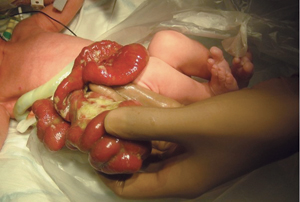Research News
Geography determines survival for babies born with birth defects
Survival for a baby born with a congenital anomaly is dependent on where it is born, confirms a recent study published in The Lancet.
Babies born with birth defects involving the intestinal tract have a one in 20 chance of dying in a high income country compared to one in five in a middle income country and two in five in a low income country.

Gastroschisis – a congenital anomaly leading to herniation of the bowel and other abdominal organs.
Scientists from 74 countries examined the risk of mortality for nearly 4,000 babies born with birth defects in 264 hospitals around the world. They compared outcomes of the seven most common gastrointestinal congenital anomalies (oesophageal atresia, congenital diaphragmatic hernia, intestinal atresia, gastroschisis, exomphalos, anorectal malformation and Hirschsprung’s disease) and identified factors associated with mortality.
Gastroschisis had the greatest difference in mortality with 90% of babies dying in low income countries compared with 1% in high income countries.
Principal Investigator Dr Naomi Wright says: “Geography should not determine outcomes for babies who have correctable surgical conditions. The Sustainable Development Goal to end preventable deaths in newborns and children under five years old by 2030 is unachievable without urgent action to improve surgical care for babies in low and middle income countries.”
Reference
- Wright N, Leather A, Ade-Ajayi N, et al. Heated, humidified high-flow nasal cannula vs nasal continuous positive airway pressure for respiratory distress syndrome of prematurity – a randomised clinical noninferiority trial. JAMA Pediatr 2016; doi:10.1001/jamapediatrics.2016.1243.
Breast milk enhances heart performance in premature babies
New research from Royal College of Surgeons in Ireland (RCSI) demonstrates the beneficial effect of breast milk consumption on cardiovascular health and early cardiovascular development in premature infants.
Published inJAMA Network Open, the study of 80 preterm infants demonstrates that those with higher exposure to their mother’s own milk had enhanced cardiac function at age one year, with values approaching those of healthy full-term infants.
Children and adults who are born preterm are at increased risk of cardiovascular disorders, and their hearts are known to have unique traits such as reduced biventricular volume, shorter length, lower systolic and diastolic function and a disproportionate increase in muscle mass. This results in impaired heart function, which is significantly lower than that of healthy infants who are born at term.
This study shows that exclusive breast milk consumption in the first months after birth is associated with a normalisation of some of these traits. Premature infants exposed to a high proportion of their mother’s own milk during the first few weeks after delivery had greater left and right heart function and structure with lower lung pressures and enhanced right heart response to stress at one year of age compared to preterm infants who had a higher intake of formula. These findings were apparent before discharge from the hospital and persisted up to a year of age (the duration of follow up).

Professor Afif EL-Khuffash.
The research was led by Professor Afif EL-Khuffash, Clinical Professor of Paediatrics at RCSI and Consultant Neonatologist at the Rotunda Hospital, Dublin.
Reference
- El-Khuffash A, Lewandowski AJ, Jain A, et al. Cardiac performance in the first year of age among preterm infants fed maternal breast milk. JAMA Netw Open 2021;4:e2121206.
Predicting premature birth sooner
A study published in the Journal of Clinical Investigation has found that mothers at risk of premature birth could be identified sooner in pregnancy than is currently possible by looking for specific bacteria and chemicals in their cervicovaginal fluid.
Researchers analysed cervicovaginal samples from 346 mothers taken at 10-15 weeks pregnant, and again at 16-23 weeks, then grouped women by their typical communities of bacteria and biochemicals. They checked this against cervical length measurements (the current standard NHS assessment for premature birth risk) and followed up to see who gave birth early.
The results showed that a specific bacterium (Lactobacillus acidophilus) limits the risk of early premature birth, which the researchers hope will lead to new preventative therapies. A combination of metabolites and bacteria were linked to birth at or before 34 weeks, while seven different metabolites were associated with birth at or before 37 weeks.
This means that those at risk of premature birth could be accurately identified much earlier in pregnancy than current tests allow, and therefore could benefit from medical or surgical treatments that aren’t possible in late pregnancy.
Reference
- laviani F, Hezelgrave NL, Kanno T, et al. Cervicovaginal microbiota and metabolome predict preterm birth risk in an ethnically diverse cohort. JCI Insight 2021;6:e149257.
Or read this article in our
Tablet/iPad edition


